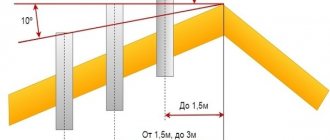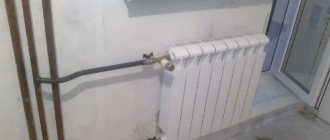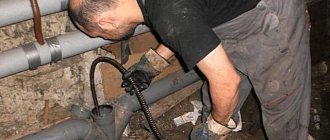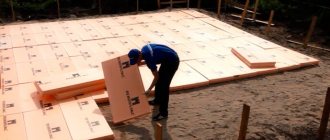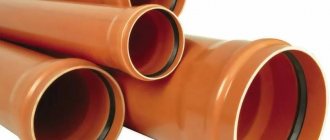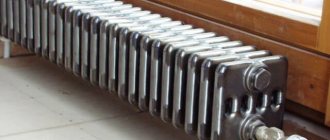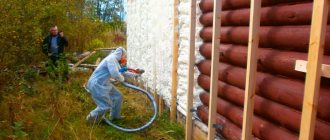Laying an internal pipeline is one of the important stages of work after the construction of individual housing. In the absence of a plan or self-installation, you often have to solve the problem of what pipe diameter to choose for water supply in a private house.
It is worth noting that to accurately determine pipe diameters, it is necessary to take into account a wide range of factors and use tabular data or formulas for calculations. On the other hand, the task is not so difficult if you use standard methods for determining pipe sizes according to repeatedly proven recommendations of specialists.
Rice. 1 Options for installing internal water supply in the house
Requirements for water supply pipes and their types
In individual houses, several types of pipes are used to supply hot and cold water. Their physical parameters ensure a long service life at the given temperature and pressure characteristics of the working environment.
Basic requirements for pipelines according to SNiP 2.04.01-85:
- They must withstand a network operating pressure of at least 4.5 bar at a cold water temperature of 20 °C for 50 years of operation.
- At a constant hot water temperature of about 75 °C, the estimated operational life of the pipeline should not fall below 25 years.
SNiP 2.04.01-85 also establishes what the internal water supply system should be like. It allows the use of polymer pipes made of low-density polyethylene (HDPE), polypropylene (PP), polyvinyl chloride (PVC), polybutylene (PB), metal-plastic, fiberglass, other plastics and their composite compounds.
From metals, it is allowed to lay pipelines made of copper, bronze, brass, steel with external and internal anti-corrosion coating.
When used in hot water supply, not all pipes satisfy these conditions, so hot and cold water pipelines are often installed from different materials.
Despite the wide range of pipes permitted for laying internal water supply systems, their use is limited by the following important factor.
The internal pipeline must have the lowest thermal conductivity to prevent heating of cold and cooling of hot water.
As a result, the list of pipes from which water supply can be made should not include all metal products. Metal-reinforced polymers - polypropylene with an aluminum shell and metal-plastic - are also not suitable.
If we exclude from consideration rare and therefore little-used pipes made of polybutylene, fiberglass, and adhesive polyvinyl chloride, then the answer to the question of which pipes are best to choose for water supply will become obvious.
Two types of pipes will remain in use, and these are PP polypropylene and HDPE low-density polyethylene. Each of these materials, due to their thick walls, has low thermal conductivity - 0.25 W/m°C for polypropylene and 0.32 W/m°C for low-density polyethylene.
Rice. 2 Examples of laying an external water main
Where does the right connection begin?
The right approach is to plan ahead. It is the creation of a scheme, a project, that represents half the success. On the plan you will need to indicate all water intake points, as well as calculate the approximate pressure power and how many liters of liquid will be consumed on average.
Thus, the beginning of water distribution work is a preliminary thorough study of all information. We recommend that you read the entire article, familiarize yourself with the sequence of work, the nuances of installation, as well as the types of pipes and water resource connection diagrams.
What diameter is specified for measurements?
Since each pipe casing has an outer and an inner diameter, it can be confusing to specify them. Any user closely involved in laying water pipes should know that pipes made of metals and plastics are measured differently.
The diameter of metal pipes is determined by their internal passage channel; it is called nominal or conditional. This is due to the fact that it is tied to the nearest value from the standardized series and does not correspond to the real value. An example of a standard numerical series of nominal diameters of steel pipes: 10, 15, 20, 25, 32, 40, 50, 65 mm.
Sometimes the diameters of steel pipelines are indicated in inches with fractions, correlating them with dimensions in millimeters: 1/2 - 15 mm, 3/4 - 20 mm, 1 - 25 mm, 1 1/4 - 32 mm, 1 1/2 - 40 mm.
The dimensions of all polymer pipes are specified by their outer diameter in millimeters. They must correspond to the standard number series, its fragment: 20, 25, 32, 40, 50, 63, 75, 90, 110 mm.
This indicator exactly corresponds to the dimensions in millimeters and is not specified in inches.
The markings of polypropylene pipes always indicate the wall thickness, making it easy to calculate the diameter of the passage channel. This may be important when carrying out hydraulic calculations.
Sometimes they are marked with the SDR symbol, which is equal to the result of dividing the outer diameter by the wall thickness. The lower the SDR, the thicker the wall the plastic pipe is considered to be.
It is worth noting that, unlike steel pipes, the dimensions of copper and stainless steel pipes are determined by their outer diameter.
| Pipes PN10 for cold water, operating temperature 20 ºС pressure 10 atm., lengths 4 m | |||
| Size mm | Outer diameter mm | Wall thickness mm | Water capacity l/m |
| 20 x 1.9 | 20 | 1,9 | 0,206 |
| 25 x 2.3 | 25 | 2,3 | 0,327 |
| 32 x 3.0 | 32 | 3,0 | 0,531 |
| 40 x 3.7 | 40 | 3,7 | 0,834 |
| 50 x 4.6 | 50 | 4,6 | 1,307 |
| 63 x 5.8 | 63 | 5,8 | 2,075 |
| 75 x 6.9 | 75 | 6,9 | 2,941 |
| 90 x 8.2 | 90 | 8,2 | 4,254 |
| 110 x 10.0 | 110 | 10,0 | 6,362 |
Advantages and disadvantages of a combined and separate bathroom
SF-mix manual up to 0.8 m3/h
AMETHYST - 02 M up to 2 cubic meters/day.
Aeration unit AS-1054 VO-90
The main advantage of combining a toilet and a bathroom is the ease of wiring. In addition, due to the absence of a wall and one door frame, the useful area can be increased; a sink and even a washing machine can be placed.
There is also a minus, it is especially noticeable with a large family - it is difficult to take bath procedures for a long time when there is a line of people wanting to go to the toilet outside the door.
Features of polypropylene pipes
Polypropylene pipes occupy a leading position in terms of the breadth of use in water supply systems of private houses and communal apartments. They have no worthy competitors in terms of cost, ease of installation and practicality when laying cold water supply (CW) mains. The main disadvantage of polypropylene is the high coefficient of linear expansion when heated, which is not an important factor in this case.
In hot water supply (DHW) pipelines, ordinary polypropylene is not used due to insufficient heat resistance and high linear elongation coefficient.
There it is better to use co-extruded material, which is a polypropylene pipe with an internal fiberglass shell. Fiberglass increases the heat resistance of the entire pipe and reduces its thermal expansion.
Polypropylene pipes are connected by soldering; if two sections of the same diameter are joined, a coupling, elbow or tee is placed on top of them, depending on the unit being mounted. This connection method is called socket connection. Thanks to this method, the flow area of the polypropylene pipeline remains unchanged in all sections. Thanks to the large number of different polypropylene fittings, almost any assembly can be soldered. When joining pipe sections of different diameters, transition couplings are used.
With the same external dimensions, the diameter of the passage channel of PP pipes is much smaller than that of metal or polymer analogues made of cross-linked polyethylene.
As for pressure characteristics, ordinary polypropylene can withstand pressure from 10 (PN10) to 20 (PN20) bar throughout its entire service life. A fiberglass-reinforced pipeline can operate for a long period at a working fluid pressure of up to 20 (PN20) or 25 (PN25) bar at elevated temperatures.
Rice. 3 Dimensions of polyethylene pipes
Price list for additional work
| Name of works | price, rub. |
| Additional work with pipes | |
| Installation of the collector (comb), replacement of the comb in a ready-made place with pipes already connected | from 1400 |
| Installation of a ball valve (under a sink, under a toilet, corner with a screen, on a riser), pcs. | 500 — 2000 |
| Installation of pressure regulator (reducing valve), pcs. | 800 |
| Replacing the fitting (fixing leaks) | 500 |
| Wall chipping up to 10 cm thick. | 500 — 1000 |
| Repairing pipe leaks | from 1600 |
| Pipe dismantling | |
| Dismantling of water supply and sewerage pipes | from 400 |
| Dismantling the comb | 500 -1000 |
| Dismantling the ball valve, pcs. * | 400 |
| Removing the pressure regulator, pcs. | 400 |
| Installation of a floor-standing toilet or wall-hung toilet and a button (without installation), pcs. | 3700 |
| Installation of a wall-hung toilet (with installation), pcs. | 4600 |
| Installation of an installation system for a toilet, pcs. | 2700 |
| Tank installation | 1200 |
| Installation of a hygienic shower with mixer | 2200 |
| Mixer installation | |
| Installation of mixer (herringbone or single lever), pcs. | 1300 — 4000 |
| Installation of a mixer with a shower head (in the bathroom), pcs. | 2000 — 4000 |
| Installation of wall-mounted mixer with thermostat (temperature regulator), pcs. | 2000 — 4500 |
| Installation of touchless mixer (electronic), pcs. | 2500 — 6000 |
| Installation of a concealed mixer (including wall slitting, pipe laying), pcs. | from 5500 |
| Sink installation | |
| Sink installation, pcs. | 1500 |
| Installation of a sink with a pedestal (Tulip type), pcs. | 1800 |
| Installation of a siphon for a sink (without installing a sink), pcs. | 800 |
| Installing a “Water Lily” sink above the washing machine + connecting a mixer | 1600 — 3000 |
| Installing the sink on brackets + connecting the mixer and siphon | 1500 — 3500 |
| Installation "Moidodyr" | 2300 — 3500 |
| Hole in ceramic | 700 |
| Installation of heated towel rails | |
| Installation of a water heated towel rail on a ready-made connection (without adjustment), pcs. | 1800 — 3000 |
| Installation of a water heated towel rail on a ready-made connection (with adjustment), pcs. | 2500 — 5000 |
| Installation of an electric heated towel rail, pcs. | 2500 — 5000 |
| Moving a heated towel rail to another wall, pcs. | from 4000 |
| Installation work | |
| Foaming a metal bath | 1000 |
| Installation and connection of a cast iron bath | 3700 |
| Installation and connection of a bathtub (acrylic\metal) | 2500 |
| Installation and connection of an acrylic bathtub with a screen | 2800 |
| Installation of a bathtub with hydromassage | 3800 |
| Hydromassage connection | 1500 |
| Waterproofing bathtub seams (sealant) | 800 |
| Installation of a plastic screen | 700 |
| Installation of a shower cabin with hydromassage without mod. sealant | 5500 |
| Installation of a shower cabin without hydromassage without sealant treatment | 4500 |
| Waterproofing glass curtains | 1500 |
| Waterproofing shower cabin seams | 2000 |
| Installation of glass curtains/doors (one leaf) | 7000 |
| Installation of glass curtains/doors (double-leaf) | 9900 |
| Installation of a tray on the floor (ceramic) with connection to the sewerage system | 2500 |
| Installation of a tray on the floor (acrylic or iron) with connection to the sewerage system | 2500 |
| Waterproofing pallet seams with sealant | 600 |
| Bidet installation | 1400 |
| Installation and connection of a urinal with internal supply | 2500 |
| Installation and connection of a urinal with external supply | 2200 |
| Installing the bidet cover (electronic seat) | 2200 |
| Installation of toilet fittings | 500 |
| Installing the toilet seat (lid) | 500 |
| Installation of a panel with flush buttons | 500 |
| Connecting a washing machine | 800 |
| Dishwasher connection | 800 |
Low pressure polyethylene pipes
HDPE pipes are used for external laying of water pipes. They are produced in lengths and coils of diameters corresponding to the standard number series.
There are several grades of polyethylene depending on its internal structure; pipes are made from PE-80 and PE-100, the latter being the best.
Unlike polypropylene pipes, the wall thickness of HDPE pipes can vary within wider limits. For them, the dimensional ratio of the outer diameter to the wall thickness SDR is also established, and it can vary in the range from 2.5 to 41.
HDPE pipes are designed to transport water with a temperature not exceeding 40 °C. It is clear that they are used only in cold water supply systems.
As for the pressure characteristics, the pressure that a HDPE pipe can withstand ranges from 2.5 to 25 bar and directly depends on the SDR.
HDPE pipes are connected using external compression couplings, so that their internal diameter remains unchanged throughout the entire pipeline.
Related article:
What is HDPE pipe
A separate article explains what HDPE pipe is - the production process, application, joining methods, installation.
Rice. 4 Installation of polypropylene and polyethylene pipes
Calculation of required building materials
The size depends on the number of plumbing fixtures and household appliances that consume the resource. In an average apartment, usually 20-22 mm in diameter is enough for risers, and 16-18 mm for bends.
The number of fittings, as well as the total length of the pipeline, is calculated based on the project. However, we recommend taking 10% more.
Factors influencing the choice of pipe diameter
The water supply pipeline is designed to transport cold and hot water of the required temperature and pressure to the points of collection. If the temperature parameters depend on the properties of the source and the thermal conductivity of the pipes, then the pressure characteristics are determined by the pipe dimensions. That is, the smaller the cross-section and the longer the length of the pipeline, the lower the water pressure will be at the end of the line.
Taking into account the above, the following factors influence the choice of water pipe diameter:
- Pressure at the inlet of the internal water supply. For individual water supply, it is set by automatic devices (pressure switches).
- Pipeline length.
- Required pressure at water points.
- The number, type and cross-section of passage channels of shut-off and control valves, metering devices, pumping equipment along the water route. Any narrowing of the passage along the watercourse path significantly increases hydraulic losses.
- The number of turns and bends in the highway. Every turn and bend creates resistance to water flow and increases hydraulic losses.
- Volumes of water consumption. The factor is directly related to the number of connection points for plumbing fixtures - the more there are, the larger the cross-section of pipes will be needed.
- Pipeline layout diagram. If the line approaches each device in series, its diameter is made larger. When using a collector line, the internal cross-section of the pipes is taken smaller.
The importance of proper design
It cannot be underestimated how important it is to create a detailed design. An incorrectly created wiring diagram can lead to rapid occurrence of malfunctions - low pressure, wear, as well as various types of leaks. In fact, the designer’s task is simple - to draw lines from the central riser of an apartment building, bypassing or passing through the water heater, to each of the liquid flow points, but in reality the master is faced with a lot of nuances.
The scheme is complicated by the presence of several bathrooms, as well as the use of household appliances that require connection to a water supply. The more plumbing facilities, the higher the load on the entire system, the more complex the project needs to be created.
As a result, here are the problems that proper design can help solve:
- improves the basic characteristics of the water supply system;
- reduces installation and operating costs;
- makes it easier to carry out repair work in the future.
What pipe diameter to choose for water supply in a private house
As shown above, the pipe diameter is specified by fixed values from a standardized number series with a significant variation. This makes accurate calculation using formulas, tables and online calculators a meaningless procedure in the vast majority of cases. Even the simplest option of determining the diameter based on the throughput of pipes and summing up the water consumption of simultaneously turned on plumbing equipment (Table 3.) is not worth the time spent and was carried out long ago by specialist installers.
Outside
If an individual water supply system is installed for a private house, then water from a submersible or surface electric pump enters it through an underground pipeline made of low-density polyethylene HDPE.
The outlet pipes of most pumps are designed to accept pipes with a diameter of 1 or 1 1/4 inches, that is, outer diameters of 25 and 32 mm. Since the pipeline from electric pumps is prohibited from being narrowed, installers have no choice which pipes to use.
Sometimes, if the outlet of the electric pump has a 1-inch (25 mm) outlet pipe, and the distance to the house is too great, a larger diameter 1 1/4-inch (32 mm) pipeline is used to reduce hydraulic losses.
The same applies when connecting from a centralized water main. In the vast majority of cases, installers do not face the question of which pipe to choose. It is enough to use two types - 25th or 32nd HDPE pipes.
Rice. 5 One of the options for manifold wiring and corresponding pipes made of thin-walled metal-plastic (for PP, all diameters should be increased by one standard size)
Stages of correct plumbing installation in an apartment, photo
Having minimal skills in working with tools, it is quite possible to replace the pipeline yourself. Here are the basic steps:
- Preparation. Includes the creation of a project, calculation and purchase of building materials.
- Dismantling of the old pipeline, if any.
- Installation according to water distribution. It includes laying, insulation (if necessary), connecting actions, for example, soldering.
- Creation of decorative elements.
We will describe the main stages in more detail.
How to make a diagram correctly
First, you should determine the material of manufacture and characteristics (stiffness, connection methods, the presence of different bends, contours, pipes, elbows and other elements are important). Then start creating the drawing. It will have:
- location of water intake points;
- pipeline laying geometry;
- building materials used;
- connection types;
- places of locking mechanisms;
- location of meters and other devices, if needed.
What do plumbers call a point?
This is the place where the outlet is inserted into the riser or the supply to the water intake device. It can be single (only cold water, as for a dishwasher or washing machine, toilet) or double, that is, together with a hot tap - shower, bathtub, jacuzzi, sink and washbasin, bidet.
Selection and preparation of materials and tools
From the list presented above, we recommend using modern, reliable products made of polypropylene or metal-plastic. They are affordable, of sufficient quality, and can withstand high temperatures. Stainless steel or copper structures are much more expensive, and you will have to work hard to install them and involve specialists. But they do not require dismantling and repair for many years.
Installation
First, choose a suitable scheme - tee or beam. Then the laying method is open or closed (in wall grooves followed by putty). Next, we carry out the work, taking into account the rules:
- the scheme always starts from a source in the apartment/house;
- you will definitely need to install shut-off valves;
- At the beginning of the entire system there must be a coarse filter; it can be ordered from;
- the height of the line is about 15-20 cm from the floor;
- the use of casing pipes will protect walls and ceilings.
Relationship between characteristics
Of all the listed factors, pressure is the fundamental point: the lower it is, the larger the diameter of the pipes for water supply in a private house should be.
If this condition is not provided for, in the presence of an open water supply circuit, noise is possible that occurs with high pressure and small diameter pipes.
You should not greatly underestimate the pressure, since water will flow out of the tap in a weak stream, which is inconvenient to use.
Department of Housing and Utilities
(approved by the Presidium of the Supreme Court of the Russian Federation on June 05, 2021) The Supreme Court of the Russian Federation clarified the differences in the classification of violations of the management company of an apartment building. The Housing Code of the Russian Federation provides for the owners of residential premises in an apartment building the right to send applications to the management organization
We recommend reading: 228 part 5 chances
The Ministry of Economic Development proposes to add two preferential years to medium-sized businesses that have become large. Companies or individual entrepreneurs will be able to retain the status of a medium-sized enterprise and the right to state support, even if the income or average number of employees exceeds the established limits. The Ministry of Economic Development submitted a project on this for anti-corruption examination.
What to do if the neighbors are not in the mood for repairs
Before starting work, you will need to enlist the support of neighbors from the apartments located above and below. It is best when the replacement of water supply risers in a building is carried out throughout the entire entrance. In this case, the reliability of the equipment over the entire height will be greatest.
In reality, not all owners of neighboring apartments are ready to meet halfway and agree to the need to repair something from nowhere. In such a situation, you simply have to connect some segment of your own riser to the existing one. Right before carrying out the work, you need to turn off the water, which you will also need to notify your neighbors about. To ensure that the residents of other apartments in the entrance experience minimal inconvenience from your replacement, it is better to carry out the planned operation in the middle of a weekday - this way you will certainly not spoil relations with the residents.
When the replacement is carried out by the management company, the following types of difficulties often arise: a number of neighbors simply do not allow the repair team into the apartments. In such a situation, you can go to court to obtain the necessary order. Or connect the pipes to an existing riser segment. The first option, of course, will require a rather long wait (often more than one month), the second is somewhat worse in terms of reliability. But the pipe segment in the ceiling will still need to be replaced.
Help about collector blocks
This is a brass or steel riser with branches. It is connected to other parts of the water supply system with threaded connections. When choosing, you need to focus on the number of outlets for pipes. On average there are 6 holes. If you need more, you can connect two or more collectors. If, on the contrary, there is an extra point for commutation, it can be closed with a plug.
Who should replace risers?
Apartment owners are often puzzled by this question. However, getting a definite answer to it is not so easy.
Replacing water supply structures falls on the shoulders of the housing office. After all, the water supply, sewerage system, and electrical network are all public facilities.
What does the law say about replacing the water supply riser in an apartment? It confirms the above provisions by the relevant acts of the Land and Housing Codes. Moreover, apartment owners pay for such a replacement as follows: the housing office includes the required amount in the payment for the apartment, which takes into account the use of risers and pipes.
When emergency situations occur, risers often break through. The natural question is: in this case, the replacement of the water supply riser in the apartment is carried out at whose expense?
In such circumstances, the housing office is obliged to take all measures to eliminate the leak as quickly as possible, and it has no right to charge additional fees from residents. If apartment owners refuse to carry out repair work, their decision must be confirmed with a written statement, which may serve as a reason for legal proceedings. In this case, the court will most likely side with the service organization.
So, if a water supply pipe needs to be replaced, you need to write an application to the appropriate management company. It is issued in the name of its director.
Before this, it would be useful to call a plumber to the apartment, who will draw up an inspection report of the equipment, indicate information about its damage and confirm that replacement is really necessary.
The application itself is drawn up in free form. It is important not to forget to justify your demand that the riser should be replaced.
The application must be completed with a specific requirement to repair or replace the riser in the apartment. Please indicate the date and sign below. The paper is drawn up in 2 copies. One remains with the applicant, the other is transferred to the management company.
The owner of the apartment who draws up the application must pay all utility bills in good faith - this is necessary so that his request can be read more quickly.
If the letter is reviewed, the management company agrees with the owner on the date and time of repair work or replacement of the riser in the apartment. This work involves the participation of specialists from the management company or its contractor.
Recommended articles on this topic:
- Arrangement of a small apartment
- Stages of renovation in an apartment
- Turnkey cosmetic repairs
The owner of the apartment will be required to have unobstructed passage from the place where the riser is located. But how much will it cost to replace an indoor riser?
Everything is very simple - when changing water supply equipment or its branches before the first connection, the apartment owner does not have to pay a penny.
But this is in theory. In practice, everything may look a little different: the owner of the apartment will read the application, take it into consideration and decide to wait in line for his fate, where he can spend years.
There are several possible ways for the situation to develop here.
- Expect an emergency with water supply, which may result in complete flooding of the entrance. Only in this case will the housing office carry out repairs (in practice, the water supply riser in an apartment is often replaced only during major repairs). Sometimes it happened that even in such a situation, restoration was done partially, and the so-called new equipment worked for a year at most.
- Gather the apartment owners and discuss with them the issue of replacing the riser at your own expense (the cost of such a procedure is approximately 3-5 thousand rubles).
So, let’s summarize how you can replace risers in an apartment through the housing office.
You need to send an application to the management company (it was discussed above). The tenant must describe a compelling reason why the replacement should be made. In addition, you must attach proof (photo evidence or examination results).
If the application is completed without errors, and the facts described in it do not contradict the law, the Housing Office must make the specified replacement or repair as soon as possible. Otherwise, the owner has the right to demand a written refusal from him, where the Housing Office will explain on what basis these works will not be performed.
If a citizen does not agree with such a refusal, it is necessary to draw up an application to the prosecutor's office; a full package of documents that the applicant has is attached to it. In addition, the law provides for the possibility of replacing a riser without the necessary permission. In this case, the initiator of such work may be the owner of the apartment.

